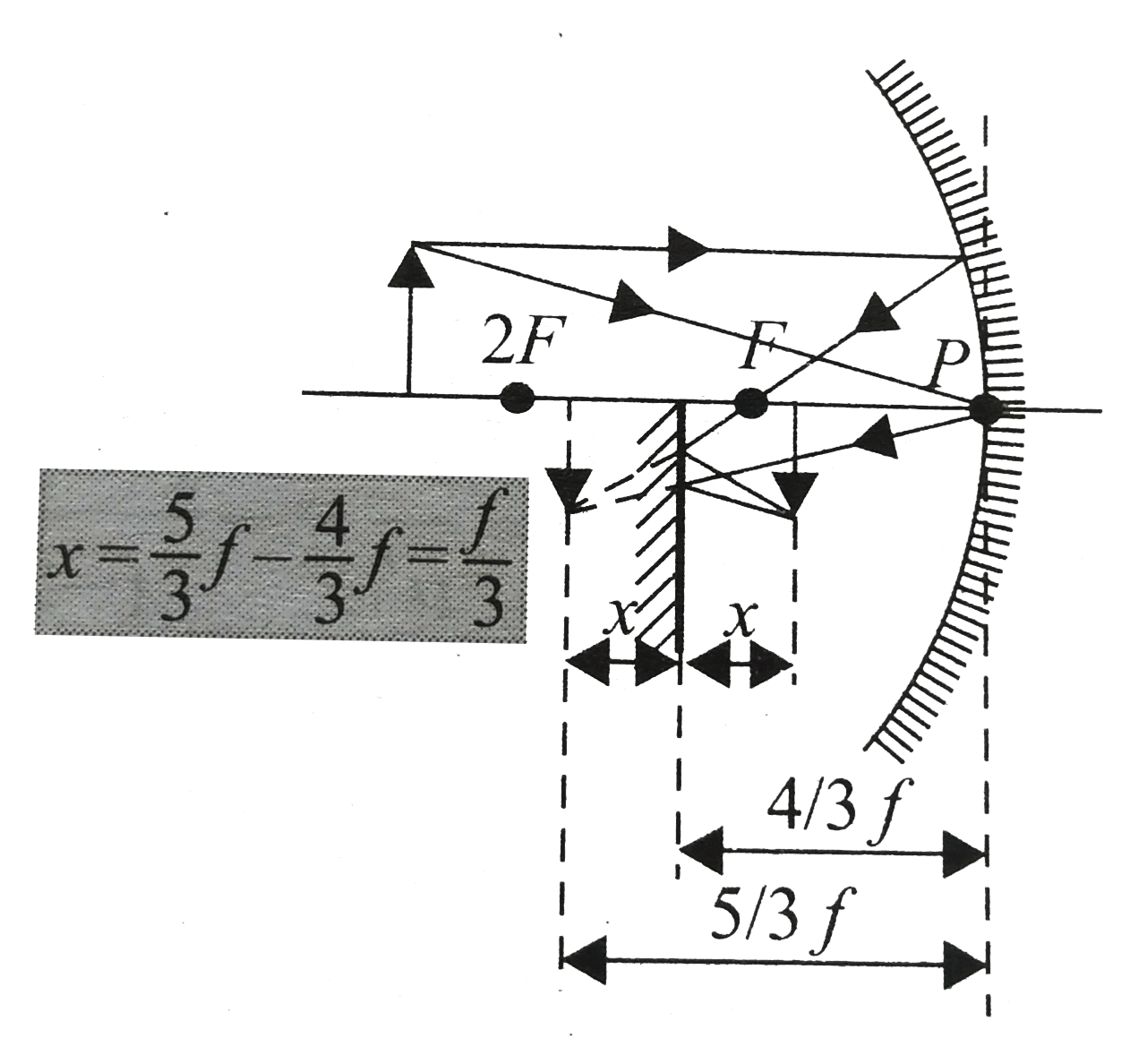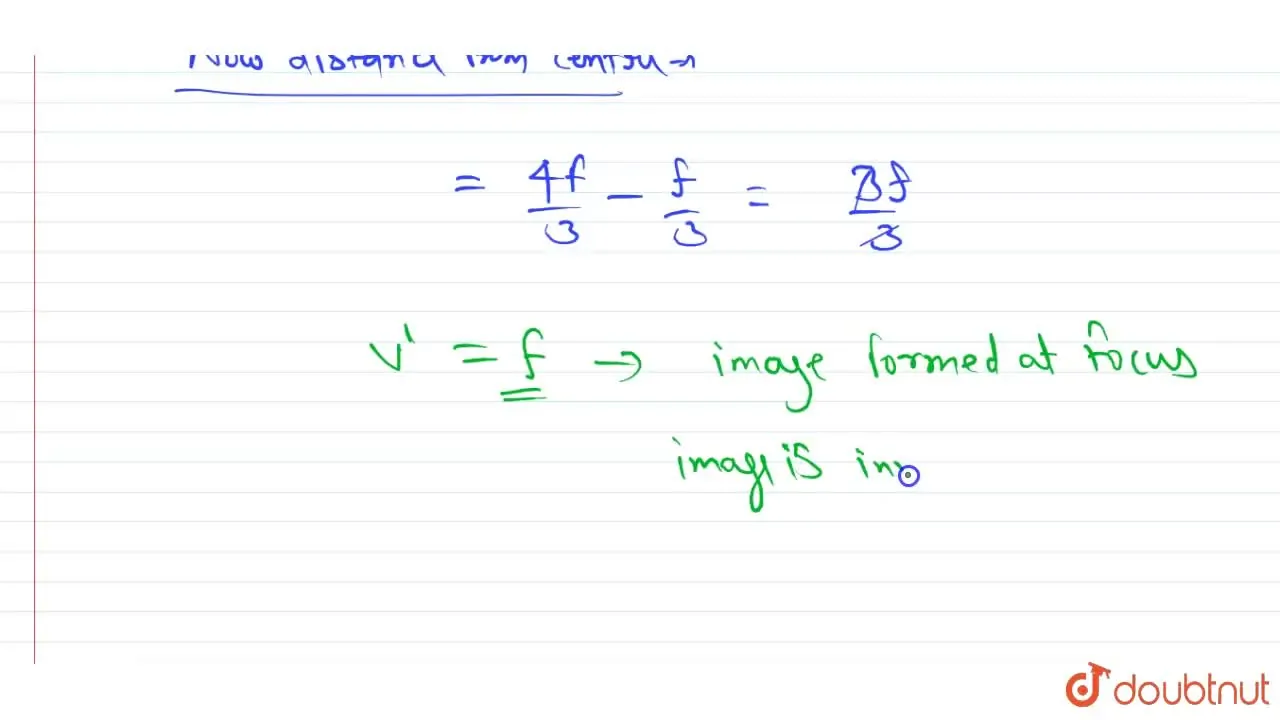Shown in Fig. is a vertically erect object placed on the optic axis at a distance (5/2)f from a concave mirror of focal length f. If a plane mirror is placed perpendicular to the optic axis at a distanc (4/3)f from the pole, facing concave mirror, find the position and nature of the final image formed.

Two rays come from the tip of the object. They converge after reflection to form a real image at I1.
Since the plane mirror is introduced in the mid, the reflected rays from the concave mirror get reflected by the plane mirror to form an imageI2. Infact I2 is the real image of teh image I1 of the object O, which serves as a virtual object to the mirror,
1u+1v+1Arr1−2.5f+1v=1−f
⇒1v=−1f+25f=−35f
⇒v=−53f
(Negative sign indicates the image is left the mirror).
⇒ The image I1 is formed which behaves as a virtual object for the plane mirror & therefore finally a real erect image I2 of same size, will be formed at equal distance x infront of the plane mirror as shown in the figure.
⇒I2 will be formed at a distance (5/3)f−2x, from concave mirror
where x=5/3f−4/3f=1/3f
⇒ The final image distance v′=(5/3)f−2(1/3f)=f
⇒ Final image i f formed at the focus.

Related Playlists
- BOOK - CENGAGE PHYSICS ENGLISHCHAPTER - GEOMETRICAL OPTICSEXERCISE - Solved Examples15videos
GEOMETRICAL OPTICS
- BOOK - CENGAGE PHYSICS ENGLISHCHAPTER - GEOMETRICAL OPTICSEXERCISE - Exercise1.114videos
GEOMETRICAL OPTICS
- BOOK - CENGAGE PHYSICS ENGLISHCHAPTER - ELECTRON,PHONTS,PHOTOELECTRIC EFFECT & X-RAYSEXERCISE - dpp 3.315videos
ELECTRON,PHONTS,PHOTOELECTRIC EFFECT & X-RAYS
- BOOK - CENGAGE PHYSICS ENGLISHCHAPTER - HEATING EFFECT OF CURRENTEXERCISE - Thermal Power in Resistance Connected in Circuit27videos
HEATING EFFECT OF CURRENT
Similar Questions
An object is placed at a distance of 20 cm from a concave mirror of focal lenght 10 cm. What is the image distance?
View SolutionAn object is placed 40 cm from a concave mirror of focal length 20 cm. The image formed is
View SolutionAn object is placed at 6 cm distance in front of a concave mirror of focal length 4 cm.
Find the position of the image period.View SolutionAn object is placed at 6 cm distance in front of a concave mirror of focal length 4 cm.
What will be the nature of the image?View SolutionAn object is placed at a distance f in the front of a convex mirror. If focal length of the mirror is f, then distance of image from pole of the mirror is
View SolutionAn object of height 2 cm is placed at a distance 20cm in front of a concave mirror of focal length 12 cm. Find the position, size and nature of the image
View SolutionAn object 4cm in size is placed at a distance of 25.0cm from a concave mirror of focal length 15.0 cm. Find the position, nature and height of the image.
View SolutionAn object is placed on the principal axis of concave mirror of focal length 10 cm at a distance of 8.0 cm from the pole. Find the position and the nature of the image.
View SolutionFor a concave mirror of focal length f, image is 2 times larger. Then the object distance from the mirror can be
View SolutionAn object is kept on the principal axis of a concave mirror of focal length 10cm, at a distance of 15 cm from its pole. The image formed by the mirror is:
View Solution


